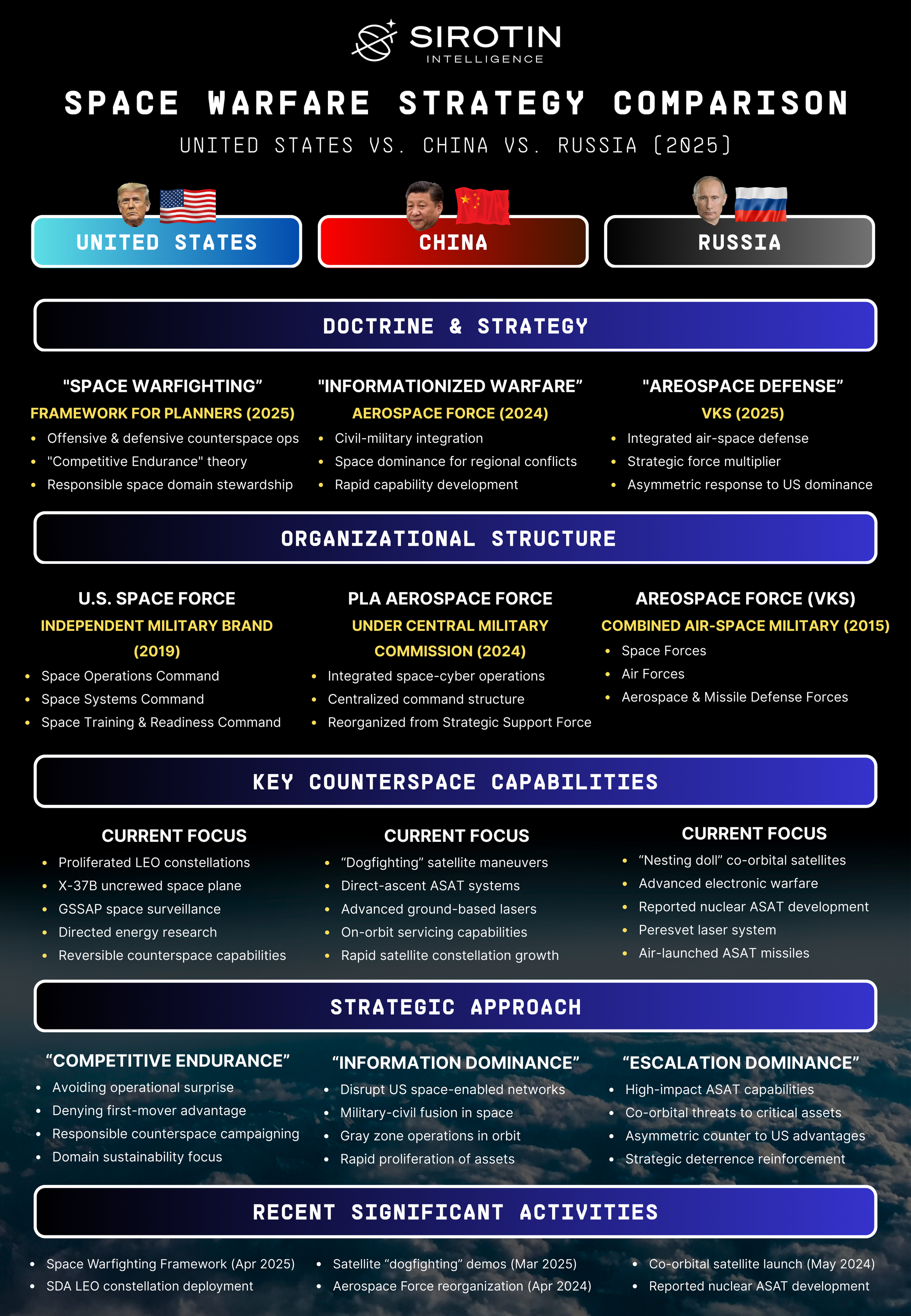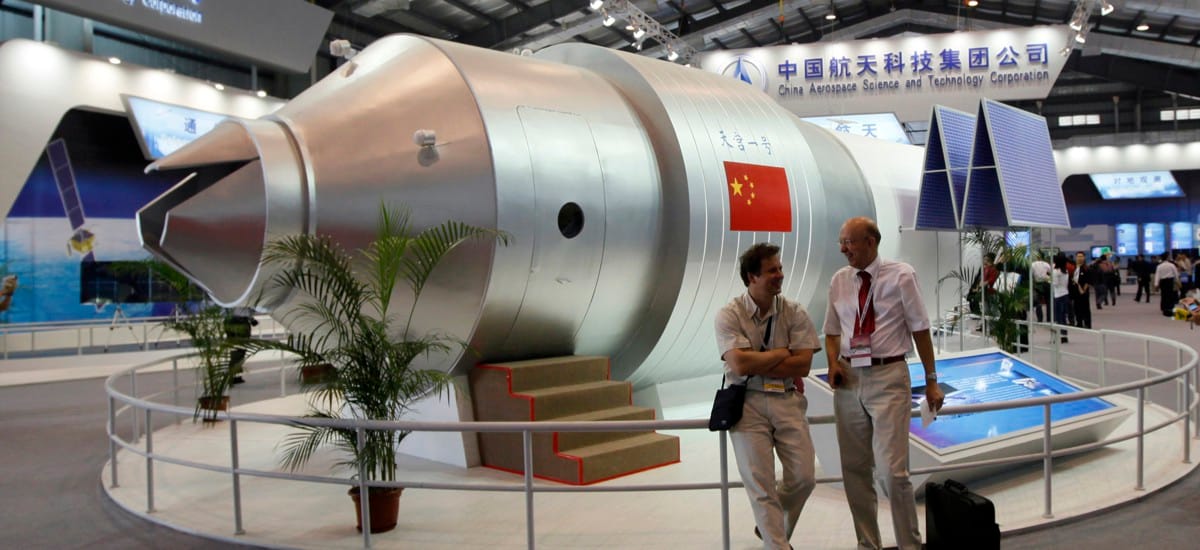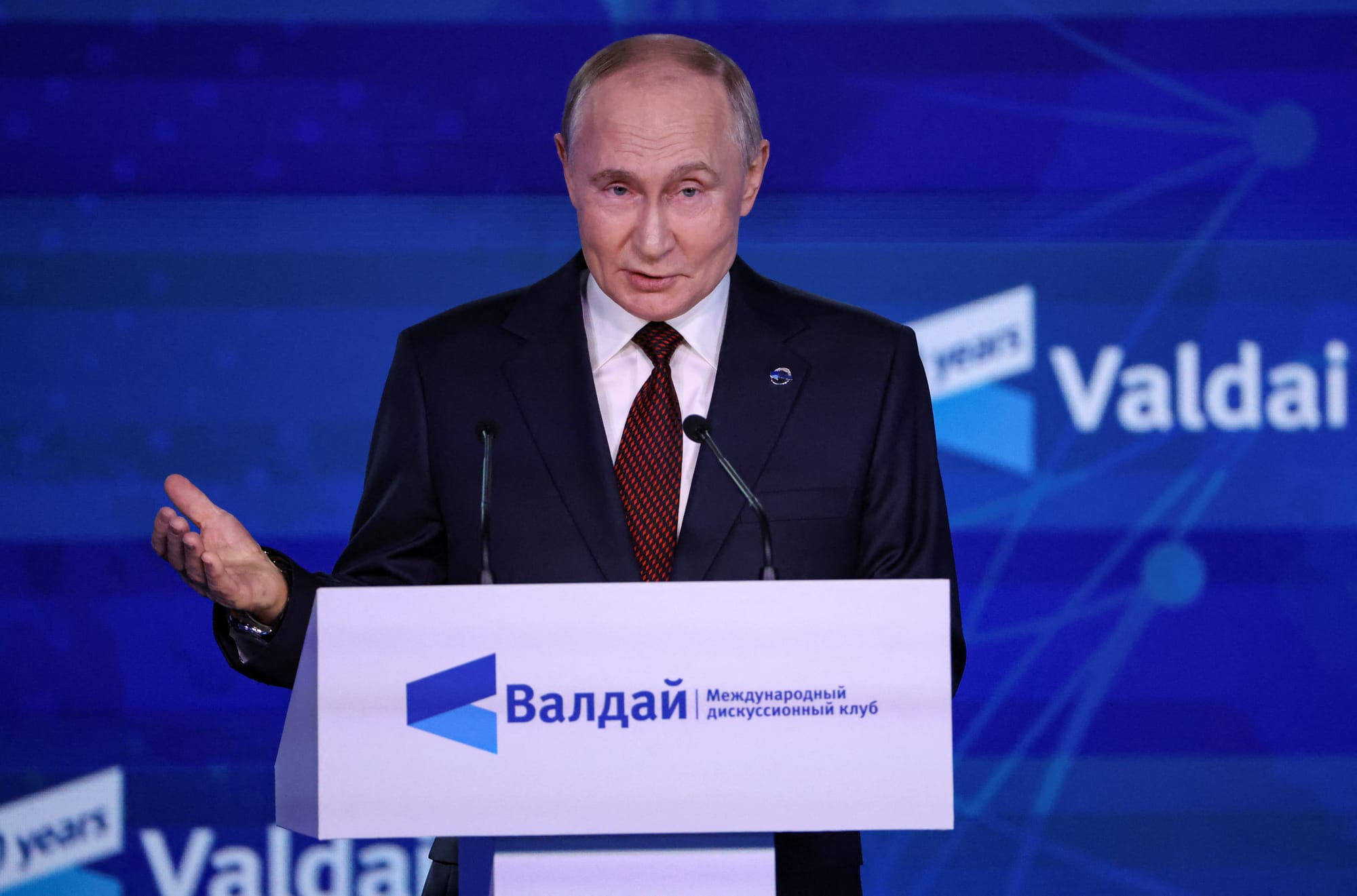Space Superiority Doctrine Emerges: Analyzing the US Space Force's 'Space Warfighting' Framework and Global Implications
Analysis of the US Space Force's new 'Space Warfighting' framework and how it positions America against Russian and Chinese space capabilities in the evolving domain of space superiority.

The opinions expressed in this analysis are those of the author and do not reflect the official position of any government or institution.
Executive Summary
The United States Space Force (USSF) has taken a significant step in defining its operational doctrine with the April 2025 release of "Space Warfighting: A Framework for Planners." This landmark publication establishes the foundational concepts and strategic principles that will guide America's newest military branch in its core mission: achieving space superiority. The framework represents the most comprehensive articulation to date of how the Space Force conceptualizes warfare in, from, and to the space domain, detailing a sophisticated model of space superiority with both spatial and temporal dimensions .
As international competition in space intensifies, this framework positions the US approach against increasingly assertive Russian and Chinese space capabilities and doctrines. Russia has demonstrated aggressive counterspace capabilities including potential orbital weapons, while China has rapidly expanded its space presence with a 560% growth in orbital assets since 2015. The framework signals a more mature and nuanced US posture that balances achieving military advantages with preserving the long-term viability of the space domain.
This analysis examines the key concepts of the framework, places them in historical context, compares US approaches with Russian and Chinese doctrines, and explores the strategic implications for the future of space security, highlighting how cultural and linguistic differences can affect interpretation of space policy statements among the competing powers.

Introduction and Context
The Evolution of US Military Space Doctrine
The USSF's "Space Warfighting" framework represents a significant evolution in US military space doctrine. Coming five years after the establishment of the USSF in 2019 and building upon its initial "Spacepower" capstone document from 2020, this framework provides operational guidance that had been previously lacking .
The document arrives at a critical juncture in the development of the USSF. As Lt. Gen. Shawn Bratton, deputy chief of space operations for strategy, plans, programs and requirements, noted, the framework represents "the natural maturing of the Space Force" as it moves beyond its establishment phase to more clearly define "how we think about warfighting in space”.
The framework's release also aligns with broader Pentagon messaging under Defense Secretary Pete Hegseth emphasizing the need for the U.S. military to adopt a stronger "warfighting mentality" as the service prepares to argue for a larger share of funding in the fiscal 2026 budget cycle.
Changing Language of Space Military Discourse
The language used by the Defense Department to describe conflict in space has evolved significantly. For years, officials used vague terms like "congested" and "contested" to discuss threats in space and employed euphemisms like "protect and defend" rather than directly addressing offensive capabilities. However, in recent months, Space Force officials have begun to speak more openly about the need for space weapons to counter Russian and Chinese capabilities.
This linguistic shift reflects a broader transformation in how military space activities are conceptualized and communicated. The framework represents the culmination of this evolution, providing explicit terminology and concepts for space warfare that were previously implied or kept classified.
Key Concepts in the Framework
Space Superiority: The Central Organizing Principle
The framework is built around the concept of space superiority, defined as the condition that "allows military forces in all domains to operate at a time and place of their choosing without prohibitive interference from space or counterspace threats, while also denying the same to an adversary."
The document introduces a sophisticated model of space superiority with both spatial and temporal dimensions:
- Spatial dimensions: General superiority (across all regions of space) versus local superiority (in specific orbital regimes or regions)
- Temporal dimensions: Persistent superiority (maintained over time) versus temporary superiority (achieved for specific operations)
This nuanced approach acknowledges that achieving complete dominance across all of space permanently is likely unattainable, marking a maturation in military space thinking.
Comprehensive Counterspace Operations Framework
Perhaps the most significant contribution of the document is its comprehensive breakdown of counterspace operations, divided into offensive and defensive actions. The document argues that space superiority is a "joint force priority" and "a necessary precondition for Joint Force success."
The framework categorizes counterspace operations into:
Offensive Actions:
- Orbital Strike: Actions taken to destroy, disrupt, or degrade adversary space platforms
- Space Link Interdiction: Actions taken to disrupt, deny, or degrade critical space links
- Terrestrial Strike: Actions targeting adversary launch vehicles, ground systems, and other terrestrial elements
Defensive Actions:
- Active Space Defense: Direct actions against threats including escort operations, counterattack, and suppression of adversary targeting
- Passive Space Defense: Measures built into systems including threat warning, military deception, hardening, dispersal, disaggregation, mobility, and redundancy
The Cyberspace-Space Nexus
A particularly noteworthy aspect of the framework is its emphasis on the relationship between space and cyberspace. As the document states, "Space and cyberspace domains overlap and are inextricable due to their interconnectedness and interdependence." The framework acknowledges that achieving cyberspace superiority is critical to ensuring space superiority, highlighting the multi-domain nature of modern warfare.
This recognition of the cyber-space nexus is particularly important as many space capabilities depend on networked systems that traverse cyberspace, creating vulnerabilities that must be defended and opportunities for offensive operations.
Historical Evolution of Space Military Doctrine
The US approach to military space operations has undergone several distinct phases since the dawn of the space age:
Early Cold War (1950s-1960s)
In the earliest phase of the space age, space was primarily viewed as an extension of air power with reconnaissance as the dominant military application. The establishment of NASA in 1958 helped maintain the "peaceful uses of outer space" narrative, even as military applications were developed.
Late Cold War (1970s-1980s)
The period saw increased militarization of space with the development of satellite systems for communications, navigation, and intelligence. President Reagan's Strategic Defense Initiative ("Star Wars") in 1983 represented the first major public initiative to develop space-based weapons systems.
See our interview with Ambassador Hank Cooper for more information.
Post-Cold War (1990s-early 2000s)
The Gulf War of 1991 demonstrated the military value of space assets for the first time in a major conflict. The US strategy shifted toward "space control" concepts while maintaining public emphasis on defensive capabilities and the peaceful use of space.
Post-Chinese ASAT Test (2007-2018)
China's 2007 anti-satellite test destroyed an aging Chinese weather satellite, creating thousands of pieces of debris and marking a turning point in space security discussions. This period saw increasing recognition of space as a "contested domain" and growing concerns about protecting space assets.
Space Force Era (2019-Present)
The establishment of the US Space Force in 2019 marked a new phase in US military space doctrine. The development of "Spacepower" in 2020 and now "Space Warfighting" in 2025 reflects the institutionalization of space as a distinct warfighting domain with its own operational concepts.
Comparative Analysis: US, Russia, and China Approaches
Russian Space Military Doctrine and Capabilities
Russia's approach to military space operations differs significantly from the US framework. While Russia maintains extensive space military capabilities, its doctrine has been less publicly articulated. Russian space military thinking tends to be integrated within broader strategic frameworks rather than developed as a standalone domain.
Russia has demonstrated some of the most aggressive counterspace capabilities in recent years. In May 2024, Russia launched what appeared to be an operational counterspace satellite into the same orbital plane as a US national security satellite, demonstrating what US Space Command's Gen. Stephen N. Whiting described as capabilities that could "target enemy spacecraft."
More recently, Russian satellites were observed practicing what a US defense official described as "attack and defend tactics" in low-Earth orbit, with "multiple Russian satellites work[ing] together to surround and isolate another satellite" in what appeared to be a demonstration of targeting capabilities.
The Russian arsenal includes:
- Direct-ascent anti-satellite weapons (demonstrated in a 2021 test)
- Co-orbital systems sometimes referred to as "nesting dolls" that can deploy projectiles at other satellites
- Sophisticated jamming capabilities actively deployed in Ukraine
- Reported development of space-based nuclear anti-satellite weapons
Russian rhetoric typically frames its space activities defensively, portraying their counterspace capabilities as responses to US "weaponization" of space. According to RAND research, both Russia and China "generally attempt to strike a rhetorical balance of characterizing U.S. actions as threatening while characterizing their own, similar actions as nonthreatening."
Chinese Space Military Doctrine and Capabilities

China's approach to military space is articulated through its Aerospace Force (reorganized from the Strategic Support Force in April 2024). China's space program is "a source of national pride and key to President Xi's 'China Dream' to establish a powerful and prosperous nation."
China has rapidly expanded its presence in orbit, with recent demonstrations of advanced capabilities. In December 2024, Beijing demonstrated what were described as "advanced co-orbital satellite maneuvers" with multiple satellites operating in close formation, described by US officials as practicing "attack approaches."
The pace of Chinese space development has been remarkable. Since the end of 2015, China's on-orbit presence has grown by approximately 560%. As of June 2024, China had more than 970 satellites in orbit, including approximately 490 satellites with intelligence, surveillance, and reconnaissance capabilities.
Chinese counterspace capabilities include:
- Anti-satellite capabilities demonstrated in the 2007 destructive ASAT test
- Ground-based laser systems developing increased power
- Extensive jamming systems
- Sophisticated cyber capabilities targeting space systems
The Chinese approach blends military and civilian space activities more extensively than the US model, creating what some analysts call "gray zone operations" in space that mix civil and military capabilities. According to a July 2024 article by analysts Mike Carey and Charlie McGillis, "intermingling civilian and military activities in space allows states to exert influence below the threshold of armed conflict."
Cultural and Linguistic Nuances in Space Security Discourse
Understanding the space security discourse among major powers requires recognizing important cultural and linguistic nuances that can significantly affect interpretation of policy statements and strategic communication. These differences extend beyond simple translation challenges to encompass deeper cultural contexts that shape how nations conceptualize space warfare and strategic competition.
Russian Linguistic Contexts and Strategic Communication
In Russian language and strategic culture, subtle differences in terminology carry significant weight that can be lost in translation. For example, the Russian language has two primary words for "brave" - "храбрый" (hrabryi) and "отважный" (otvazhnyi). While both translate as "brave" in English, "храбрый" typically connotes straightforward courage and valor, while "отважный" often carries implications of daring or risk-taking that might be considered reckless.

These linguistic nuances appeared in the geopolitical dialogue during Putin's November 2024 Valdai Discussion Club speech, where he praised then-President-elect Trump following the US election. Putin described Trump as having behaved in a "very correct way, courageously, like a real man" following the assassination attempt against him. The specific Russian phrasing used connoted not just bravery but a form of calculated daring that Putin seemed to respect and perhaps signaled a broader strategic message about his expectations for Trump's approach to international relations, including in space.
Similarly, the Russian concept of "strategic deterrence" (стратегическое сдерживание) differs significantly from Western understandings. As noted in contemporary analysis, Russian strategic deterrence is a "clustered term" that encompasses containment of threats, deterrence of aggression, and coercion of adversaries "to cede in a confrontation to terms dictated by Russia." This broader conceptualization helps explain why Russian statements about space capabilities may seem contradictory or overly aggressive to Western observers.
Russian military thought also makes "a substantial deviation from the term 'strategic communication'," preferring instead concepts like "information security" and "information warfare." This difference reflects Russia's view of information spaces—including space-based communications—as zones of "constant struggle for supremacy and control," effectively declaring "a permanent state of war in the information sphere."
These communication differences extend to diplomatic and strategic interactions. Russian communication tends to be "more direct and straightforward," often valuing "honesty and clarity more than politeness." This directness can lead Western analysts to misinterpret Russian strategic statements about space as more threatening than intended, or conversely, to miss subtle warnings embedded in seemingly routine announcements.
Chinese Strategic Terminology and Conceptual Frameworks
Chinese strategic communication about space capabilities employs specific cultural framing that can be easily misunderstood by Western analysts. Several key concepts shape Chinese thinking about space warfare:
The ancient concept of "shi" (势) represents strategic advantage through positioning and potential energy. Often mistranslated simply as "position" or "momentum," shi encompasses a complex understanding of how forces align to create advantage. In space doctrine, this might manifest as China positioning seemingly benign capabilities that could, when properly aligned, create unexpected strategic leverage.
The principle of "warfare is a way of deception" from Sun Tzu provides another framework for Chinese strategic communication. Chinese military texts expand this into specific methods, where showing oneself "to intimidate the enemy" or creating "momentum to harass the enemy" become operational concepts applied to space systems. Understanding these cultural references is critical for interpreting Chinese statements about their space capabilities.
More recently, China has developed the concept of "cognitive domain operations" (认知域作战, renzhiyuzuozhan) as a "next-generation evolution of psychological warfare" that uses information to influence adversaries' cognitive functions. This concept extends from peacetime public opinion to wartime decision-making and is increasingly applied to space operations. When Chinese officials discuss space transparency or cooperation, these statements should be understood within this broader framework of cognitive influence.
The traditional "Thirty-Six Stratagems" continue to influence Chinese strategic thinking, including concepts like "hiding a knife behind a smile" (笑里藏刀) that emphasize charming an adversary while secretly moving against them. This approach manifests in China's dual-use space technologies and cooperative space initiatives that may have hidden strategic purposes.
Implications for Space Strategy Interpretation
These cultural and linguistic differences create significant challenges for interpreting space security strategies across major powers:
- Translation Distortion: Direct translations of key strategic concepts often lose crucial connotations and cultural contexts. Terms like "space superiority," "responsible behavior," and "defensive capabilities" carry different implications across languages.
- Strategic Ambiguity: What appears as deliberate strategic ambiguity in space doctrine may sometimes be the result of cross-cultural misinterpretation rather than intentional policy.
- Signaling Misalignment: Signals intended as warnings or reassurances may be misinterpreted due to different cultural frameworks for understanding strategic communication.
- Assessment Challenges: Intelligence assessments of adversary space capabilities and intentions are vulnerable to cultural biases that can lead to either overestimation or underestimation of threats.
- Negotiation Obstacles: International space governance efforts face additional hurdles when fundamental concepts are understood differently by participating nations.
Understanding these cultural dimensions is not merely an academic exercise. As space competition intensifies, misinterpreting strategic signals due to cultural or linguistic differences could lead to dangerous miscalculations. Building cross-cultural expertise in space security discourse should be a priority for all major space powers to reduce these risks and develop more effective channels of communication.
The same cultural and linguistic considerations apply to interpreting the Space Warfighting framework itself. Western analysts must recognize that how terms like "space superiority," "counterspace operations," and "defensive actions" are understood by Chinese and Russian strategic planners may differ significantly from US conceptions, creating potential for misalignment in strategic expectations and responses.
Critical Assessment of the Framework
Strengths of the US Space Warfighting Framework
The Space Warfighting framework represents a significant step forward in US military space doctrine, providing a "lexicon for counterspace operations" and detailing a range of "defensive and offensive actions Guardians may take to maintain space control." Its key strengths include:
- Doctrinal Clarity: By defining key terms and concepts, the framework provides a common language for planners, operators, and acquisition specialists.
- Nuanced Approach to Superiority: The framework's recognition that space superiority has both spatial and temporal dimensions shows a sophisticated understanding of the unique characteristics of the space domain.
- Integration with Joint Operations: The framework effectively connects space superiority to broader joint military objectives, ensuring space operations are not conducted in isolation.
- Balanced Offensive-Defensive Approach: The equal emphasis on offensive and defensive capabilities reflects a mature understanding of deterrence requirements.
Limitations and Challenges
Despite its strengths, the framework faces several challenges:
- Resource Constraints: As noted by Vice Chief of Space Operations Gen. Michael A. Guetlein, the Space Force is dealing with a flat budget of approximately $30 billion—"a drop in the bucket" compared to the rapid development of adversary capabilities.
- Technological Gaps: The framework describes capabilities that are not yet fully developed or deployed, creating potential gaps between doctrine and operational reality.
- Escalation Risks: The framework does not fully address the risks of escalation in space conflicts, particularly given the growing reliance on space assets by all major powers.
- Domain Sustainability Concerns: While the framework acknowledges the need to preserve the space domain's viability, there are tensions between this goal and the pursuit of military advantage.
Implications for International Security
The Great Power Competition in Space
The evolving space competition presents significant security challenges. As Gen. Guetlein observed, "What has become abundantly clear to us is that the adversary has been watching us for the past 20-plus years and the way we operate...They've been studying the way our economy works, our way of life, and they have not only become very intent on denying our ability to use space, but they've become very capable at it as well."
This competition is marked by:
- Technological Acceleration: All three major space powers are developing increasingly sophisticated counterspace capabilities at what Gen. Guetlein has described as "an eye-watering pace."
- Demonstration of Capabilities: Recent activities such as Russia's deployment of counterspace satellites, China's demonstration of "dogfighting" satellite maneuvers, and the US publication of more explicit counterspace doctrine all represent moves in a strategic signaling game.
- Evolving Operational Concepts: The shift from traditional space architectures (a few large, expensive satellites) to proliferated constellations represents a fundamental change in how space warfare might be conducted.
- Escalation Risks: The development of more capable counterspace weapons, including potential nuclear options, raises the stakes considerably, with global implications for all space users.
Competing Visions for the Space Domain
The US Space Force's framework emphasizes "Competitive Endurance" as a long-term approach to space competition that balances the pursuit of space superiority with safeguarding "the safety, security, stability, and long-term sustainability of the space domain." This approach stands in contrast to more aggressive postures demonstrated by Russia and China.
The fundamental tensions between these approaches will shape the future of space security:
Conclusion
As General Saltzman notes in the conclusion of the Space Warfighting framework: "there are no set answers, no textbook solutions, and no guarantees of success. The Guardian must understand the principles and, when necessary, break the rules to uncover the military genius in spacepower."
With the release of this framework, the Space Force has staked out its doctrinal territory and defined how it intends to secure America's vital interests in space for decades to come. The key challenges ahead include:
- Balancing Deterrence and Restraint: Creating sufficient counterspace capabilities to deter adversaries while avoiding an unconstrained arms race that could render space unusable.
- Establishing International Norms: Despite tensions, developing agreed-upon rules of behavior in space to reduce risks of miscalculation.
- Architectural Resilience: Implementing new approaches to space architecture that can survive in contested environments without excessive cost.
- Cross-Domain Integration: Ensuring space operations are fully integrated with other domains, particularly cyberspace, where the boundaries with space operations are increasingly blurred.
- Commercial Integration: Effectively leveraging the explosion of commercial space capabilities while managing the security implications of their involvement.
How Russia, China, and other spacefaring nations respond to this framework will shape the evolving security environment in space for the coming decades. The competition for space superiority is likely to intensify, with profound implications for international security both in space and on Earth. Understanding the cultural, linguistic, and strategic differences in how these major powers approach space security will be crucial for interpreting their actions and developing effective responses in this increasingly contested domain.
Glossary of Terms
- ASAT: Anti-satellite weapon
- Counterspace: Military operations designed to attain and maintain a degree of space superiority
- LEO: Low Earth Orbit (typically 100-1,200 miles above Earth)
- Orbital Strike: Actions taken to destroy, disrupt, or degrade adversary space platforms in the space domain
- Passive Space Defense: Measures inherent in the design of space assets that minimize the effectiveness of threats
- Space Domain Awareness (SDA): The ability to detect, characterize, attribute, predict, and target activities in space
- Space Link Interdiction: Actions taken to disrupt, deny, or degrade an enemy's critical space links
- Space Superiority: The condition that allows forces to operate without prohibitive interference from space threats
- Terrestrial Strike: Actions taken to destroy, disrupt, or degrade adversary space systems in terrestrial domains
TL;DR — The US Space Force's new "Space Warfighting" framework represents a significant evolution in military space doctrine, detailing a comprehensive approach to achieving space superiority through offensive and defensive operations while competing with increasingly sophisticated Russian and Chinese counterspace capabilities.





